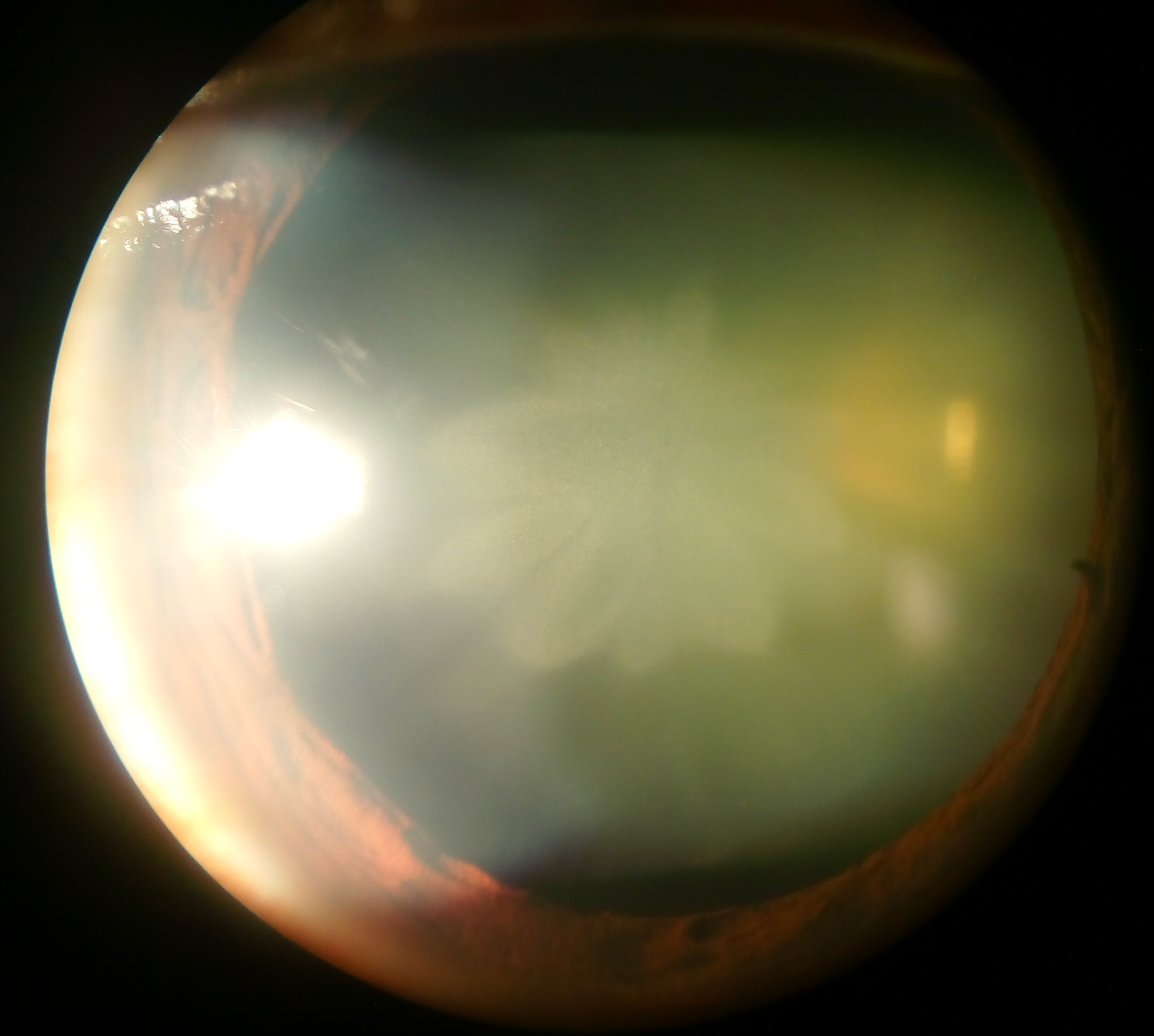|
Anil Kumar Mandal
Anil Kumar Mandal is an Indian ophthalmologist and a consultant at L. V. Prasad Eye Institute, Hyderabad. Known for his research on glaucoma, Mandal is an elected fellow of the National Academy of Medical Sciences. The Council of Scientific and Industrial Research, the apex agency of the Government of India for scientific research, awarded him the Shanti Swarup Bhatnagar Prize for Science and Technology, one of the highest Indian science awards, for his contributions to Medical Sciences in 2003. Biography Anil K. Mandal was born in a village named Ghanashyambati, South 24 Parganas district in the Indian state of West Bengal to Jayalaxmi and Manik Chandra Mandal.He did his primary education in Parvati FP School under guidance of his father who was Headmaster of the same school. His secondary education was in Bawali Higher Secondary School.'Sangeetanjali' composed by Dr.Anil Kumar Mandal published by Gitanjali, Kolkata 137 He graduated in medicine in 1981 from Nil Ratan Sir ... [...More Info...] [...Related Items...] OR: [Wikipedia] [Google] [Baidu] |
South 24 Parganas, West Bengal
South 24 Parganas (Pron: pɔrɡɔnɔs; abbr. 24 PGS (S)), or sometimes South Twenty Four Parganas and Dakshin 24 Parganas, is a district in the Indian state of West Bengal, headquartered in Alipore previously, with its Zilla Parishad now in Baruipur. It is the largest district of West Bengal by area and second largest by population. It is the sixth most populous district in India (out of 640). On one side of the district there is the urban fringe of Kolkata, and on the other the remote riverine villages in the Sundarbans. History Originally, the capital of Raja Bikramaditya and Maharaja Pratapaditya was at Dhumghat. Later it was transferred to Ishwaripur (Originated from the name Jeshoreshwaripur). Maharaja Pratapaditya declared the independence of South Bengal from the Mughal Empire. Pratapaditya's father Shrihari (Shridhar), a Kayastha, was an influential officer in the service of Daud Khan Karrani. Upon the fall of Daud, he fled with the government treasure in his custod ... [...More Info...] [...Related Items...] OR: [Wikipedia] [Google] [Baidu] |
Aphakia
Aphakia is the absence of the lens of the eye, due to surgical removal, such as in cataract surgery, a perforating wound or ulcer, or congenital anomaly. It causes a loss of ability to maintain focus ( accommodation), high degree of farsightedness ( hyperopia), and a deep anterior chamber. Complications include detachment of the vitreous or retina, and glaucoma. Babies are rarely born with aphakia. Occurrence most often results from surgery to remove a congenital cataract. Congenital cataracts usually develop as a result of infection of the fetus or genetic reasons. It is often difficult to identify the exact cause of these cataracts, especially if only one eye is affected. People with aphakia have relatively small pupils and their pupils dilate to a lesser degree. Causes Surgical removal of a lens, mainly in cataract surgery, is the most common cause of aphakia. Spontaneous traumatic absorption or congenital absence of lens matter is rare. Traumatic subluxation or disloca ... [...More Info...] [...Related Items...] OR: [Wikipedia] [Google] [Baidu] |
Buphthalmos
Buphthalmos (plural: buphthalmoses) is enlargement of the eyeball and is most commonly seen in infants and young children. It is sometimes referred to as buphthalmia (plural buphthalmias). It usually appears in the newborn period or the first 3 months of life. and in most cases indicates the presence of congenital (infantile) glaucoma, which is a disorder in which elevated pressures within the eye lead to structural eye damage and vision loss. Signs and symptoms Buphthalmos in itself is merely a clinical sign and does not generate symptoms. Patients with glaucoma often initially have no symptoms; later, they can exhibit excessive tearing (lacrimation) and extreme sensitivity to light (photophobia). On ophthalmologic exam, a doctor can detect increased intraocular pressure, distortion of the optic disc, and corneal edema, which manifests as haziness. Other symptoms include a prominent eyeball, Haab's striae tear in the Descemet's membrane of the cornea, an enlarged cornea, and my ... [...More Info...] [...Related Items...] OR: [Wikipedia] [Google] [Baidu] |
Trabeculectomy
Trabeculectomy is a surgical procedure used in the treatment of glaucoma to relieve intraocular pressure by removing part of the eye's trabecular meshwork and adjacent structures. It is the most common glaucoma surgery performed and allows drainage of aqueous humor from within the eye to underneath the conjunctiva where it is absorbed. This outpatient procedure was most commonly performed under monitored anesthesia care using a retrobulbar block or peribulbar block or a combination of topical and subtenon (Tenon's capsule) anesthesia. Due to the higher risks associated with bulbar blocks, topical analgesia with mild sedation is becoming more common. Rarely general anesthesia will be used, in patients with an inability to cooperate during surgery. Procedure An initial pocket is created under the conjunctiva and Tenon's capsule and the wound bed is treated for several seconds to minutes with mitomycin C (MMC, 0.5–0.2 mg/ml) or 5-fluorouracil (5-FU, 50 mg/ml) soaked s ... [...More Info...] [...Related Items...] OR: [Wikipedia] [Google] [Baidu] |
Aniridia
Aniridia is a condition characterized by the absence or near absence of the iris, the colored, muscular ring in the eye that controls the size of the pupil and regulates the amount of light entering the eye. This absence results in a primarily black appearance of the central eye. Aniridia can be congenital, typically affecting both eyes, or caused by a penetrant injury. Congenital aniridia is not simply an iris defect but a more complex condition affecting multiple parts of the eye, with macular and optic nerve hypoplasia, cataract, and corneal changes. Vision may be severely compromised and the disorder is frequently associated with several other ocular complications, including nystagmus, amblyopia, buphthalmos, and cataract. In some cases, aniridia occurs as part of a broader syndrome, like WAGR syndrome ( kidney nephroblastoma, genitourinary anomalies and intellectual disability) or Gillespie syndrome ( cerebellar ataxia). PAX6 The PAX6 gene, located within the AN2 ... [...More Info...] [...Related Items...] OR: [Wikipedia] [Google] [Baidu] |
Indian Journal Of Ophthalmology
The ''Indian Journal of Ophthalmology'' is a peer-reviewed open-access medical journal published on behalf of the All India Ophthalmological Society. The journal publishes articles on ophthalmology and vision science. Abstracting and indexing The journal is indexed in Abstracts on Hygiene and Communicable Diseases, Biological Abstracts, BIOSIS Previews, CAB Abstracts, CINAHL, EBSCO, Excerpta Medica/ EMBASE, Expanded Academic ASAP, Global Health, Health & Wellness Research Center, Health Reference Center Academic, MEDLINE/Index Medicus, PubMed, SafetyLit, Science Citation Index Expanded, SCOLOAR, Scopus, SIIC databases, SNEMB, Tropical Diseases Bulletin, and Ulrich's Periodicals Directory. As of 2025, the h-index is 55 and the 5-years h-index is 93, ranking the ''Indian Journal of Ophthalmology'' at the 8th position in Google Scholar Google Scholar is a freely accessible web search engine that indexes the full text or metadata of Academic publishing, scholarly literature ac ... [...More Info...] [...Related Items...] OR: [Wikipedia] [Google] [Baidu] |
Pediatric Glaucoma
Primary congenital glaucoma is a rare eye condition that is present at birth or develops early in childhood. It occurs due to improper drainage of the eye's fluids, which leads to increased pressure inside the eye, known as intraocular pressure. This elevated pressure can damage the optic nerve which will result in permanent vision loss. It is also known as pediatric glaucoma or childhood glaucoma, and was previously known as trabeculodysgenesis or goniodysgenesis. Types Primary congenital glaucoma is classified into three subtypes: * true congenital glaucoma, which causes signs of increased intraocular pressure within the first month of life, * infantile glaucoma, which presents between one month and three years, and * juvenile glaucoma, which becomes clinically apparent after three years of age and before age 40. Primary juvenile glaucoma Primary juvenile glaucoma becomes apparent between the ages of 3 and 40. It develops due to ocular hypertension and is diagnosed between t ... [...More Info...] [...Related Items...] OR: [Wikipedia] [Google] [Baidu] |
Pediatric Ophthalmology
Pediatric ophthalmology is a sub-specialty of ophthalmology concerned with eye diseases, visual development, and vision care in children. Training In the United States, pediatric ophthalmologists are physicians who have completed medical school, a 1-year internship, 3-year residency in ophthalmology, and a 1-year fellowship in pediatric ophthalmology and strabismus. Pediatric ophthalmology fellowships in the United States are accredited by the American Association for Pediatric Ophthalmology and Strabismus. Clinical expertise Pediatric ophthalmologists focus on the development of the visual system and the various diseases that disrupt visual development in children. Pediatric ophthalmologists also have expertise in managing the various ocular diseases that affect children. Pediatric ophthalmologists are qualified to perform complex eye surgery as well as to manage children's eye problems using glasses and medications. Many ophthalmologists and other physicians refer pediatric ... [...More Info...] [...Related Items...] OR: [Wikipedia] [Google] [Baidu] |
Cataract
A cataract is a cloudy area in the lens (anatomy), lens of the eye that leads to a visual impairment, decrease in vision of the eye. Cataracts often develop slowly and can affect one or both eyes. Symptoms may include faded colours, blurry or double vision, halos around light, trouble with bright lights, and Nyctalopia, difficulty seeing at night. This may result in trouble driving, reading, or recognizing faces. Poor vision caused by cataracts may also result in an increased risk of Falling (accident), falling and Depression (mood), depression. Cataracts cause 51% of all cases of blindness and 33% of visual impairment worldwide. Cataracts are most commonly due to senescence, aging but may also occur due to Trauma (medicine), trauma or radiation exposure, be congenital cataract, present from birth, or occur following eye surgery for other problems. Risk factors include diabetes mellitus, diabetes, longstanding use of corticosteroid medication, smoking tobacco, prolonged exposu ... [...More Info...] [...Related Items...] OR: [Wikipedia] [Google] [Baidu] |
National Board Of Examinations
National Board of Examinations in Medical Sciences (NBEMS) is an autonomous body under the Ministry of Health and Family Welfare, Government of India, and established in 1975 at New Delhi as a Society under Delhi Society registration act, to standardizing postgraduate medical education and examination in India. The postgraduate degree awarded by the National Board of Examinations is called the Diplomate of National Board (DNB) for specialty and Doctorate of National Board (DrNB) for superspecialty. The list of recognised qualifications awarded by the Board in various specialties and super-specialties are approved by the Government of India and are included in the First Schedule of Indian Medical Council Act, 1956. The National Board of Examinations conducts the largest portfolio of examinations in the field of medicine in India Examinations The National Board of Examinations in Medical Sciences conducts the following examinations: Entrance exams * NEET-PG for admission to ... [...More Info...] [...Related Items...] OR: [Wikipedia] [Google] [Baidu] |
Diplomate Of National Board
The Diplomate of National Board (DNB) is a postgraduate degree in medicine awarded by the National Board of Examinations in Medical Sciences (NBEMS) under the Ministry of Health and Family Welfare, Government of India, on completion of three-year training in any of 30 broad specialties. DNB is equivalent to the Master of Medicine (MD), Master of Surgery (MS), Doctor of Medicine (DM), and Master of Chirurgiae (MCh) in all purposes. Doctors who already hold an MD/MS/DM/MCh are eligible to directly appear in the DNB final examination. Doctorate of National Board (DrNB) is a post MD/MS/DNB super speciality degree awarded by NBE. It is equivalent to Doctorate of Medicine (DM) / Master of Chirurgiae (MCh) degrees awarded respectively in medical and surgical super specialities. Demand Doctors who already hold an MD/MS/DM/MCh are eligible to directly appear in the DNB exit examinations in their specialty. In 2023, about 50 percent of the candidates who attended the DNB exit examinat ... [...More Info...] [...Related Items...] OR: [Wikipedia] [Google] [Baidu] |



